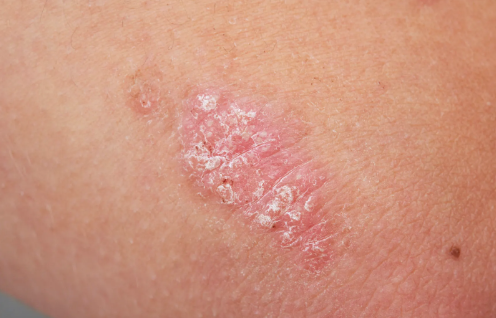Psoriasis is more than just a skin condition—it’s a persistent, chronic autoimmune disease that profoundly affects millions of individuals worldwide. It manifests in various forms, each with its own severity and symptoms, significantly impacting life quality. This detailed guide aims to explore the depths of psoriasis, discussing its types, appearances, symptoms, causes, and management strategies.
What is Psoriasis?
Psoriasis is characterized by an accelerated skin cell production that leads to thick, red, scaly patches on the skin surface. These patches can cause significant discomfort, including itching and pain. The disease stems from an immune system malfunction, prompting skin cells to regenerate at an abnormal pace.
The Science Behind Psoriasis
At its core, psoriasis involves an overactive immune response, with white blood cells (T-cells) mistakenly attacking healthy skin cells. This accelerates the skin cell lifecycle, causing cells to surface on the skin’s outer layer in days rather than weeks. These cells build up, forming the characteristic plaques associated with the condition.
What are the Types of Psoriasis?
Understanding the types of psoriasis is crucial for diagnosis and treatment. The disease manifests in several forms, each with distinct characteristics:
- Plaque Psoriasis (Psoriasis Vulgaris): This is the most common type, affecting about 80% of psoriasis patients. It features raised, inflamed, red lesions covered by silvery white scales, typically found on the elbows, knees, scalp, and back.
- Guttate Psoriasis: This type appears as small, dot-like lesions, often starting in childhood or young adulthood. It is sometimes linked to bacterial infections, such as strep throat.
- Inverse Psoriasis: Found in the body’s skin folds (underarms, groin, under breasts), this form presents as bright red, shiny lesions that may worsen with friction and sweating.
- Pustular Psoriasis: Characterized by white pustules surrounded by red skin, this rare form can be localized or widespread.
- Erythrodermic Psoriasis: The most severe form of psoriasis, erythrodermic psoriasis covers large areas of the body with a fiery redness that can be itchy or painful and can lead to severe illness.
Each type requires specific management strategies, which are essential for controlling the disease’s progression and impact.
What Does Psoriasis Look Like?
The appearance of psoriasis can vary significantly depending on the type and severity of the condition. Generally, psoriasis is characterized by patches of red, inflamed skin covered with silvery scales. These patches, or plaques, can crack and bleed in severe cases. For those looking to understand the visual aspect of psoriasis, viewing psoriasis pictures can provide a clearer picture of the condition’s impact on the skin.
What are the Symptoms of Psoriasis?
Psoriasis symptoms can vary widely, often fluctuating in severity over time. Common symptoms include:
- Plaques of Red Skin: The most noticeable symptom, these are often covered with loose, silver-colored scales.
- Dry Skin: Psoriatic skin may crack and bleed.
- Itching and Burning: These symptoms can range from mild to severe.
- Painful Joints: Over time, psoriasis can lead to psoriatic arthritis, characterized by swollen, painful joints.
- Nail Changes: Psoriasis can cause nail pitting, abnormal nail growth, and discoloration.
Symptoms can exacerbate due to certain triggers, which include stress, changes in weather, and medications.
What Causes Psoriasis?
While the exact cause of psoriasis remains unclear, it is known to be an immune-mediated disease influenced by genetic and environmental factors. Triggers that may initiate or worsen an outbreak include:
- Genetic Predisposition: Many individuals with psoriasis have a family history of the disease, suggesting a strong genetic link.
- Immune System Triggers: An infection or an illness can prompt the immune system to start behaving erratically, often initiating a psoriasis flare-up.
- Environmental Factors: Weather changes, particularly cold and dry conditions, can trigger a psoriasis outbreak.
What Causes Psoriasis Outbreaks?
Identifying and understanding triggers is crucial for managing psoriasis. Common triggers include:
- Stress: High stress levels can lead to new psoriasis flare-ups or worsen existing patches.
- Skin Injury: Scratches, sunburns, or vaccinations can trigger the Koebner phenomenon, where new skin lesions appear at the site of skin injury.
- Medication: Certain medications, including beta-blockers and lithium, can provoke psoriasis outbreaks.
- Infections: Throat infections, particularly streptococcal infections, are known to trigger guttate psoriasis, a type that appears as small, dot-like lesions.
- Managing these triggers through lifestyle adjustments and medical treatments can significantly reduce the frequency and severity of psoriasis outbreaks.
Conclusion
Psoriasis is a complex autoimmune condition that not only affects the skin but can also deeply impact an individual’s emotional and physical well-being. Although it is a chronic disease with no cure, effective management through medication, lifestyle changes, and regular medical care can help minimize symptoms and improve the quality of life for those affected. Advances in medical research continue to provide new insights into the treatment and understanding of psoriasis, offering hope for better therapeutic options in the future.
FAQs
- Is psoriasis contagious?
- No, psoriasis is not contagious and cannot be spread from person to person through skin contact or other means.
- Can psoriasis affect more than my skin?
- Yes, psoriasis is an autoimmune disease that can also lead to psoriatic arthritis, affecting the joints. Additionally, people with psoriasis are at increased risk for other serious health conditions, including cardiovascular diseases and diabetes.
- What are the best practices for managing psoriasis?
- Managing psoriasis typically involves a combination of treatments, including topical creams, phototherapy, systemic medications, and biologic drugs. Lifestyle modifications, such as maintaining a healthy weight, avoiding alcohol, and managing stress, are also beneficial.
- How do I know which type of psoriasis I have?
- A dermatologist can diagnose the type of psoriasis you have based on the appearance of your skin, your medical history, and, if necessary, a skin biopsy. Proper diagnosis is crucial for effective treatment.
- Can diet influence psoriasis symptoms?
- While no definitive diet cures psoriasis, some people find that certain foods exacerbate their symptoms. It can be helpful to keep a food diary to track and identify any foods that might trigger an outbreak.
- What are the latest treatments for psoriasis?
- Recent advancements in psoriasis treatment include new biologic drugs that specifically target the immune system pathways involved in psoriasis. These treatments have been effective in reducing symptoms for many patients and are generally used in moderate to severe cases.
- How can I support a loved one with psoriasis?
- Support for someone with psoriasis includes understanding the condition, recognizing the physical and emotional impact it can have, and encouraging effective treatment and lifestyle choices. Emotional support can also make a significant difference in managing the psychological aspects of the disease.
- Is sunlight good or bad for psoriasis?
- Moderate sunlight exposure can improve psoriasis symptoms for some people because UV rays slow the growth of skin cells. However, it’s important to avoid sunburns, which can worsen psoriasis and increase the risk of skin cancer.




